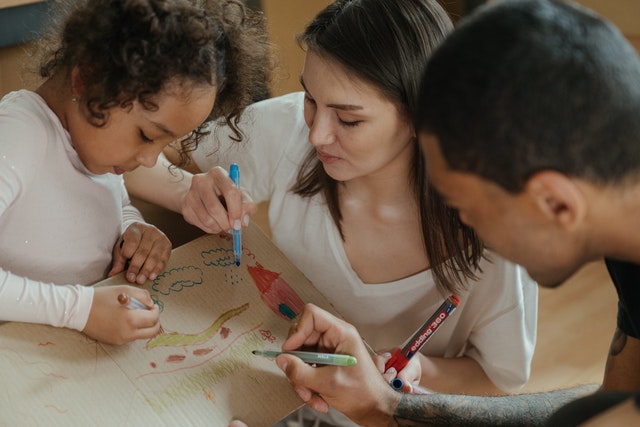24 Tips for How to Help Kids Adjust to an International Move
Moving to another country can upend the entire world for a small child. How do you ease the transition? Here are our best tips for how to help kids adjust to an international move.

HOW CAN I HELP MY CHILD ADJUST TO ANOTHER COUNTRY?
This is the nagging question with which every expat parent must wrestle.
You don’t want to scar your child while embracing this new and exciting life change. But just how do you protect and nurture them through a move?
While there is no foolproof plan, there are some excellent practices that you can implement to emotionally and relationally support your child as they transition.
Of course, moving has different effects on various ages. So let’s start with a brief word about babies and toddlers and how they might differ quite a bit from older children.
Just a warning: this is going to be a long post because we’re going to try to cover it all. Here is your key to finding exactly what you need:
MOVING OVERSEAS WITH A BABY
When you move to another country with a baby, you might find that your baby registers very little difference. As long as his routine goes uninterrupted, he can adjust quickly and easily–in general.
However, that is the key: keeping his routine. And sometimes it seems nigh impossible to do this.
So what can you do to help a baby have a smooth transition to another country? Here are a few tips:
- Carry your baby in a baby wrap or baby carrier. (Our favorites are the Baby K’Tan Breeze carrier and the Infantino Flip.) This can help your baby feel close to you and safe.
- Try to minimize startling sounds and lights. This isn’t always possible. However, try your best. This will help your baby not to feel overwhelmed–which can lead to bad sleep.
- Keep as much of your daily routine with your baby as possible. Try to continue your rhythm of life just like you did before you moved. This will help your baby to feel safe and secure.
- Make sure your baby is well-fed and well-rested. Lack of food and sleep can lead to a lot of unnecessary crying. Don’t ignore your baby’s needs as you attend to your long moving to-do list.
MOVING ABROAD WITH A TODDLER
A toddler’s needs during a transition (such as an international move) will sometimes be very similar to a baby’s, depending on the child’s personality.
But there will also be significant differences.
A toddler is able to understand changes in the world around them in a way that babies are still developing. Toddlers notice when something is missing, when someone leaves, and when routines go out of wack.
So what are some simple ways to help a toddler during a big move to another country? Here are some tips:
- Reassure your toddler of your love, care, and protection often. Very often.
- Help your toddler to “preview” the move by reading books about moving. This might help him to understand what is happening to him a bit more clearly and with less anxiety.
- Do a “practice move.” Pack a bag and venture out to a family member’s or friend’s house. Talk about how you will soon do this with all of your things. Reassure your toddler when any fears arise. This is a great way to discover and discuss those fears!
- Keep as much of your daily routine with your toddler as possible. Just like with a baby, keeping your natural rhythm of life can help a toddler feel secure and more in-control.
- Make sure your toddler is well-fed and well-rested. Lack of food, water, and sleep never made life with a toddler any easier. 😉
- Expect tantrums and meltdowns. Because toddlers can’t express their emotions very specifically, they sometimes feel overwhelmed by their feelings of fear, anxiety, insecurity, etc. Reassure them of your love and care in these moments.

HOW LONG DOES IT TAKE KIDS TO ADJUST TO MOVING?
How long does it take you to adjust to a move? How long does it take your friend?
Just like adults can have individual timelines for adjusting to a major life change like an international move, so too children vary in the length of time that they need to adjust.
The important thing is to not rush your child. Don’t try to make their emotional needs and processes fit within your timeline. Support them with lots of love, cuddles, reassurance, and conversations.
WHAT ARE SOME SIGNS OF MOVING ANXIETY IN CHILDREN?
It’s important to watch for signs of distress and anxiety in children. Sometimes, they won’t verbalize their feelings, and looking for physical and behavioral clues can help you as a parent address their emotional needs.
- More-than-normal emotional outbursts.
- Crying over the smallest of things.
- Misbehavior that is not typical of them (or in higher volume than is typical).
- Lack of expression of any kind. No joy, sadness, or opinions.
- Withdrawal from relationships.
- Not seeming to care about pets, favorite toys, hobbies, etc.–or even harming or destroying these formerly beloved things.
- Suddenly getting poor grades (before or after moving).
- Nail biting, skin picking, hair pulling, etc. that they did not engage in before the news about the move.

HOW DOES MOVING COUNTRY AFFECT A CHILD’S DEVELOPMENT?
Moving is a big change. But make a move to another country and you add entirely new layers onto the complicated nature of moving.
Here are some major ways in which moving country changes a child’s world and affects his development:
- Language. Unless you already speak the language of the country to which you are moving, then the linguistic differences will be BIG for a small child. We noticed with our eldest son (a toddler during our major international moves) that the constant changing of languages led him to some confusion. He did a lot of code-mixing (speaking in multiple languages in one sentence) and sometimes was very hesitant to speak. Moving can affect a child’s language development and also willingness to speak. It might even change their expression of their personality–at least for a time.
- Routine. If you’re moving internationally, then the initial time change might be a big hurdle for a child. But even after that first adjustment, there might be other changes in daily routine as a family or for your child as an individual. These changes in routine can affect a child’s sense of well-being and security in positive or negative ways.
- People. The same family and friends that your child associates with “home” will not be in your new country. This affects a child’s relational identity and might affect his/her social abilities.
- Culture. The mindset and beliefs (worldview) behind cultures are so drastically different in many cases. It can be a huge mystery for a child to understand why specific values are emphasized more than others or why a teacher allows students to cheat on a test. This can influence a child’s perception of morality and also tradition.
- Transportation. Some modes of transportation might not be as common (or accessible as others). And a child can either see this as a new adventure or as a threat. If a child does not grow up with riding in cars, he might also need a bit more driving instruction when it comes time for him to apply for a license.
- School. School in another language, school with different values, school with a different grading system–school is so different in each nation. School can influence a child’s perception of his or her own identity, likes and dislikes, and abilities.
- Possibilities for hobbies and interests. Some former interests that your child held might not be so common in the new country. If he loved badminton before but the basketball is all the rage in his new nation, then there might not be many opportunities to explore his hobby. This might change his interests or cause him to become even more devoted in pursuing them.
- Natural environment. Sometimes moving to another country involves a complete change of scenery–from farmhouse to city apartment, or from a condominium to a rural landscape. These changes can affect how children understand the world and how they interact with nature.

TIPS FOR MOVING ABROAD WITH FAMILY
1. Tell your child(ren) about the move early and gently.
Don’t wait until the last minute or make it a “fun” surprise. Children need time to adjust mentally–sometimes more time than we realize.
2. Prepare yourself mentally that your child’s reaction to the international move might not be exactly what you would choose.
Phrase your language and reactions in such as a way as to not presuppose what your children will (or must) feel. Instead, try to make it clear that you want them to express their own opinions.
3. Don’t negate your children’s feelings about the move. Allow them to feel.
It’s ok if your children feel upset. It doesn’t mean that they won’t ever feel excited about the move. Don’t make it mandatory that they reflect your own feelings.
4. Meet your child’s anger, misbehavior, protests, and anxiety with gentleness and reassurance of your love and care.
Even if you don’t like how your child responds, make sure to demonstrate your love and care for him in the midst of his feelings. Shouting him out of his feelings or trying to convince him that he doesn’t really feel that way (or shouldn’t) won’t be helpful and will only shut down further conversation and relational connection.
5. Set up traditions and routines that you can continue anywhere. (Specific foods, bedtime rituals, daily schedule, birthday celebrations, etc.)
Daily rhythms and yearly celebrations help us as human beings to feel secure. We know what to expect, and we feel valued and noticed. How much more so for children, who don’t have much control over their lives? Keeping the same routines can help them adjust more quickly to other changes.
6. Make significant memories during your last months in your old home (or country).
Together with your child, make a bucket list of things that you want to do, foods you want to eat, and people you want to see.
7. Take photos of their memorable spots, beloved people, and possessions.
In our digital age, photos are easily accessible memories. When your child is grieving the loss of her old home, seeing (or even holding) a photo of it might help ease her heartache.
8. Try to bring emotionally significant possessions with you.
If your child has a special attachment to a belonging, then make a special effort to bring it with you. If you can’t bring the entire thing, then maybe bring a piece of it.
9. Give them time to say goodbye to a pet and help the pet adjust to a new home.
Let them help you explain how to care for the pet to its new owners.
10. Show photos of your new home, community, and people.
Anticipation is one of the most exciting parts of an international move. Help your child form realistic and accurate expectations of his new home by providing him with photos.
11. Read books about your new home (community, state, country).
Reading stories can give children a narrative for their new life. And informational books can also help them to know what to expect.
12. If possible, let them write to (or call) someone in the new place–or better yet, arrange a visit.
Allaying some children’s fears and anxiety is as easy as helping them to gain a connection to their new life. Letters, calls, and visits can allow them to form new relationships, which gives them something to anticipate with joy about their new home.
13. Write a storybook about your move, featuring your child as the main character.
You can write this together or make it yourself to read to your child. Either way, use it as a way to discuss the move–the process, the destination, and any fears, concerns, expectations, or excitement that your child holds.
14. Make plans for your first month in the new place. What are some sightseeing things (or homemaking things) you could do together?
Just like a bucket list before you leave, plans for your first few weeks in your new home can help you measure time and also build excitement.
15. Make a goodbye video or letter.
Let your child say everything they want to say about why they love their old home and how they feel about their new home.
16. Record videos of your old home.
These videos can document your child’s old life for them. In the future, when they feel that the memories are fuzzy or they feel especially sentimental, these videos can provide clear visuals.
17. Bring pieces of “home” with you.
What shows your child that this is “home”? For my eldest, it was a set of water-pour bath toys. As silly and small as that may sound, it was significant to him.
18. Stop and give attention and affection to your child.
This is not a formal thing. In fact, it’s best if you intersperse these little “attention” moments throughout your day—especially if your child is having a rough day with lots of misbehavior and emotions.
19. Plan a one-on-one date with your child.
What is something that he/she would like to do “one last time” before moving? Do it together! Or what is one special restaurant he/she enjoys? Spend a meal there together!
20. Pray together for your new home and your old home.
What better to do for worries and fears than to put them in God’s hands? Moving to another country can be a great time of faith-building for your child. And as you pray together, you can draw closer to God and to each other.
21. Have your child draw a picture of your old home and put the drawing in a special place.
What will your child remember most about this place? Then have them draw a picture of their new home. This will reveal a lot of expectations (including fears) that your child may have.
22. Plan a goodbye party.
This could be at school, at home, at church–or all three.
23. Give your child (and yourself) time and space to grieve.
We too easily rush past grief. Maybe we think that it negates our excitement and appreciation of our new home and community. Or maybe we believe that if we allow ourselves to feel it, it will get worse.
But none of these things are true. Instead, if we stuff our feelings and try to repress them, they might actually cause more problems.
This is especially true of young children. If we don’t allow them to cry, how else can they express their emotions of grief over their loss of home and friends? They might actually act out more if they don’t feel safe to express their feelings.
24. Let your child help you pack.
There is something about the physical act of packing that can help bring some closure to a place and season of time. As your child packs with you, recount the ways that you used these belongings in your old home and dream of how you will use them in your new home.

CLOSING THOUGHTS ON TIPS FOR HOW TO HELP KIDS ADJUST TO AN INTERNATIONAL MOVE
We find ourselves within the throes of yet another international move this month. And then in a few more months, we will whittle down our belongings again, pack up our bags, and prepare our hearts for boarding another international flight that will lead us to our new home.
Whether you move frequently or plan on moving only once, my hope is that these tips help you as you guide your child through this special season of life.
For tips on traveling with young children (including babies and toddlers), check out my post all about Travel Tips and also my list of important medicines to take with you on a trip with toddlers and adults.
All the best!









